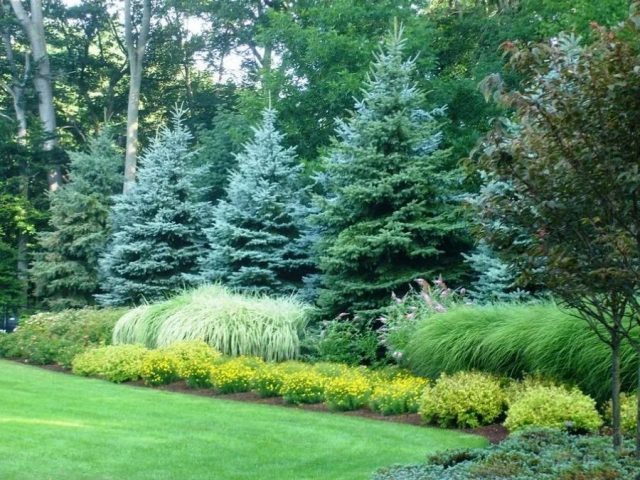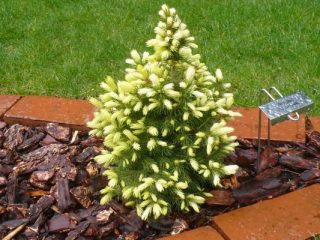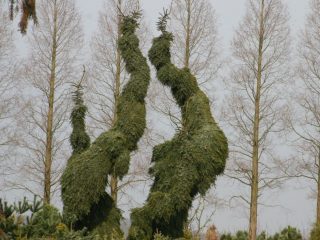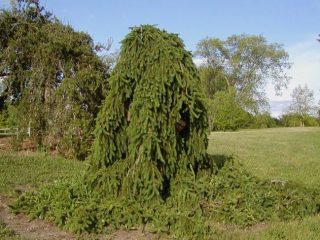Content
Types of spruce trees are presented in a wide variety. Before planting a coniferous tree on a site, you need to study the characteristics of the varieties.
What does a spruce look like?
Spruce (Picea) is a coniferous tree of the Pine family. It has a variable root system - taproot in the first 15 years, then superficially branched. The trunk of the tree is covered with thin gray or red-brown lamellar bark, which thickens, becomes rougher and becomes cracked with age. The shoots are horizontal and weeping; instead of leaves, they have tetrahedral or flattened needles. The needles are completely renewed within six years; per year the tree loses up to 15% of its green cover.
At the age of 10-60 years, the plant begins to bear female and male strobili.The first are located at the ends of the shoots and form cones over time, the second are small earrings located in the axils of the needles on annual branches. Pollination of the plant occurs in May.
Mature cones are woody or leathery, up to 15 cm long, consisting of an axis and numerous scales. The seeds of the plant ripen in October and spread with the wind; germination persists for up to ten years.

The lifespan of spruce is on average 250-300 years
Spruce trees of various types are distributed throughout Russia, found in the northern USA and China, Sweden and Finland. The coniferous crop forms dense and dense forests, prefers good sunlight, but is shade-tolerant.
What kind of spruces are there?
Trees are usually divided into categories according to external characteristics. First of all, they are evaluated by height and outline.
By shape
The crown of a tree is one of three types:
- pyramidal - usually tall varieties more than 10 m in adulthood have this shape;
- cone-shaped or spherical - slow-growing ornamental trees have a crown with non-standard geometry;
- creeping, or weeping - some varieties of common spruce fall into this category.
Pyramid trees are most often chosen for single planting. Low varieties with a figured crown are used to form artistic compositions.
By height
Under natural conditions, trees of most species grow up to 30-50 m above the ground. But decorative varieties are usually divided into several categories according to height:
- tall - trees reach 10-17 m or more above the ground surface;
- medium-sized - height is 2-5 m;
- low-growing - compact trees grow up to 0.5-2 m.
When choosing, you need to take into account the characteristics of the site and think in advance how the plant will fit into the landscape design.
Varieties of fir trees for the garden: photos and names
There are several dozen varieties of spruce trees in Russia and other countries. In this case, the most popular trees can be identified.
Norway spruce or European spruce
Norway spruce (Picea abies) is a large tree with a pyramidal crown, pointed at the top. The height reaches a maximum of 50 m, the branches of the plant are horizontal or directed downwards, with raised ends. The tree's needles are glossy, lush green, formed by long tetrahedral needles.
The spruce species in Russia is found in the Central region up to the Urals. It is distinguished by its endurance and requires the simplest care.

The common spruce bears seeds every 4-6 years.
Serbian spruce
Serbian spruce (Picea omorika) is a rare tree in the natural environment, but common in cultivation. Reaches 20-35 m in height, has a narrow, almost columnar crown. The trunk diameter is about 1 m.
The branches of the tree are rather short, raised, covered with yellowish bark. The needles are slightly flattened, dark green or bluish shiny above, whitish below. The cones of the plant are spindle-shaped, dark purple or almost black in color when young, and brown when ripe.

Serbian spruce occurs naturally in a limited area in the Balkans
Canadian spruce or blue spruce
Canadian spruce (Picea glauca) is naturally distributed in North America, reaching a maximum of 30 m above the ground surface. When grown in summer cottages, it usually stretches only up to 10-15 m. It has a dense, wide-pyramidal crown, the tree’s needles are bluish and thick.The cones on the shoots first form light green, and then darken to a brown tint.

Blue Canadian spruce is characterized by increased drought resistance
Engelmann spruce or weeping
Engelman spruce (Picea engelmanii) is a crop native to North America, common in the Rocky Mountains region. It is distinguished by a wide cone-shaped crown, the branches of the tree are sloping, and the needles are sharp and bluish-green in color. The oblong cones acquire a burgundy hue when ripe.

Engelmann spruce reaches 50 m in the wild; in cultivation it rarely rises above 15 m
Prickly or blue spruce
Prickly spruce (Picea pungens) is frost-resistant and tolerates unfavorable environments. The crown of the tree is wide-pyramidal, dense, the branches are horizontal, raised at the ends. The needles of the decorative spruce variety are gray and gradually turn green with age.

In its natural environment, prickly spruce grows in western North America
Black spruce
Spruce with soft needles called black (Picea mariana) when cultivated reaches a maximum of 3 m. The branches of the tree are brown-red, with reddish pubescence, the needles are dense, bluish-green. The shoots form a pyramidal crown. The tree tolerates cold weather well and is not afraid of drought and unfavorable ecology.

Black spruce is found in temperate climates and permafrost areas
Siberian spruce
Siberian spruce (Picea obovata) is a slender tree up to 35 m tall with a conical crown. The lower shoots of the plant are located close to the ground. The needles are dark green, the needles are sharp and shiny, up to 3 cm in length. The spruce species for the Urals is characterized by slow development and good endurance.

The Siberian species can also be found in the northern regions of Europe and China
Eastern spruce
Oriental spruce (Picea orientalis) is found in Turkey and the Caucasus. Reaches 60 m in height in nature, has a symmetrically developed pyramidal crown. Fast-growing varieties of spruce add up to 20 cm per year. The needles are rich green, hard and thick, the cones are oblong, red-purple in color.

Eastern spruce does not tolerate frost and heavy soils.
Spruce mariorica
Mariorika spruce (Picea mariorika) is a hybrid obtained by crossing the Serbian and black species. It grows up to 30 m above the ground, the crown is spreading and wide, round in shape. Horizontal shoots are covered with bluish needles, and there are silvery stripes on the needles below. The cones of the species are small, only up to 5 cm in length, and are red-brown in the early stages of development.

The mariorica species was bred at the beginning of the twentieth century in Europe
Ayan spruce
The tall type of spruce for landscape design reaches 10 m in cultivation. The tree's needles are dark green with bluish stripes at the bottom. The needles fit tightly to the shoots. Ayan spruce (Picea jezoensis) bears long purple or light green cones that gradually darken to brown.

The Ayan species is found naturally in China, Japan and the Far East.
Schrenk's spruce
The type of decorative spruce is common in Central Asia - in Kazakhstan, China, Kyrgyzstan. The crown is cylindrical or narrow pyramidal, the needles are diamond-shaped. The trunk diameter of the Schrenk spruce (Picea schrenkiana) can reach 2 m. The bark of an adult tree is rich brown, with a lamellar structure.

Schrenk spruce reaches 60 m in height in nature
Decorative varieties of fir trees with photos and names
Varieties of spruce trees for dachas are presented in large quantities. There are several popular varieties that are distinguished by their unpretentiousness and beauty.
Aurea
The popular spruce variety Aurea has a pyramidal crown. By the age of ten it reaches 2 m above the ground, then it begins to grow faster and eventually stretches up to 7 m. The shoots of the variety are prostrate, with bluish-green short needles and young golden growths.

The Aurea variety is often planted against a background of conifers with richer greenery to create contrast
Kupressina
Cupressina is a beautiful variety of spruce up to 12 m above the ground. The crown has a conical shape, the needles are short and green. The tree bears pink cones; over time they acquire a reddish-brown color. The variety can be planted separately or in compositions. The tree is not afraid of strong winds and easily tolerates short droughts.

Cupressina is hardy, but does not react well to polluted air.
Nana
Nana is a low variety of spruce, reaching only 50 cm above the ground even in adulthood. It has a rounded, slightly flattened crown, the plant’s needles are bluish, young annual needles are bright green. The Nana variety grows only 5 cm per year.

With low growth, the Nana variety spreads up to 1 m in diameter
Oldenburg
The medium-sized spruce variety Oldenburg is a tree with a cone-shaped crown. Grows up to 15 m above the ground, has silver-gray long needles. It has good frost resistance, so it is popular both in the middle zone and in the Urals and Siberia.

The Oldenburg variety is characterized by slow development and reaches a height of more than 1 m only after ten years of life.
Kruenta
Cruenta is a winter-hardy low variety of spruce with a moderate rate of development. The shape of the tree is regular pyramidal, the branches are raised obliquely upward, the side shoots droop. A distinctive feature of the variety is its crimson growth, which turns green over time. The cones are also red-purple when young, but later darken.

The Kruenta variety adds 10-20 cm throughout the year
Frohburg
The weeping variety Frohburg has a straight trunk and long branches that fall to the ground and can form a creeping trail with age. The tree's needles are light green and rigid. The plant produces reddish cones that darken as they mature. Fresh growths of the variety are dark, emerald green.

By the age of ten, the Frohburg variety reaches an average of 4 m
Konika
The shade-loving spruce variety Conica has a conical regular shape and usually grows only up to 2 m. The tree's needles are juicy green, soft and elastic. The variety develops slowly and does not require decorative pruning. The tree is often planted in rocky gardens, on hills and in mixed borders.

The Konica variety can spread up to 1.5 m in diameter
Other
In addition to the most popular varieties, lesser-known varieties also deserve attention. We can list several beautiful and hardy ornamental spruce trees.
Peve Tijn
A low-growing variety of Dutch selection grows up to 6 cm per year. The tree's needles are green with golden and bluish hues. The variety looks especially bright when planted in sunny areas; its annual growths are very different in color from old needles. The crown of the tree is dense, cone-shaped with a smooth surface.

The Peve Tejin variety grows to an average height of 1.8 m
Alberta Globe
A miniature variety with a rounded crown acquires a dome-shaped shape with age. Reaches 1 m in height and approximately 70 cm in diameter, develops very slowly. The variety's needles are light green, lush and dense. The tree is well suited for planting in rockeries or flower beds on light soils.

The Alberta Globe variety adds up to 3 cm per year
Belobok (Bialobok)
This unusual variety of white-tipped spruce reaches 2 m in adulthood. The branches of the tree are short and strong, the needles are yellowish-cream on young shoots and silvery-blue in adulthood. The variety is recommended to be planted on moderately moist soils in sunny areas.

Belobok tolerates winter frosts down to -35 ° C
Sanders Blue
The blue variety with a conical, regular crown grows up to 1.5 m above the ground by the age of ten. It has bright silver-blue needles, bluish-green on older branches. When planting a tree in the shade, color heterogeneity becomes more noticeable. The variety grows up to 70 cm in width and thrives on loose, light soils.

The Sanders Blue variety adds up to 5 cm during the season
Bush's Lace
A beautiful spruce variety with a loose crown develops quickly and adds up to 30 cm per year. In adulthood it reaches 7 m above the ground, spreading up to 2 m wide.
It has cascading branches, the lower shoots descend to the ground surface and form a trail. The variety's needles are bluish, with bright silver-blue growths.

It is recommended to place the Bush Lace variety in sunny areas
How to choose
When choosing a spruce variety for a site, you need to consider several factors:
- Plant height. Dwarf species are usually purchased for small gardens. If the dacha is large, then miniature trees will get lost in the landscape design. In spacious areas, it is better to plant tall plants with lush pyramidal crowns singly or in small groups.
- Frost resistance. Most varieties easily tolerate Russian winters. But there are also heat-loving varieties that react sensitively even to moderate frosts. Before purchasing, you need to make sure that the plant will not die in a specific climate zone in the first year after planting.
- Lighting requirements. In general, the plant is considered shade-tolerant. But some varieties are designed for planting in sunny areas. First of all, this concerns species with bright decorative young growth. In the shade, such plants will develop slowly and also lose their effectiveness.
When purchasing a spruce seedling of any variety, you need to pay attention to its quality. The plant should have well-developed roots and a fresh, bright crown. If the tree is stunted, the needles have turned yellow and are falling off, you should refuse to purchase it.
Conclusion
The types of spruce trees are very diverse. There are tall and short trees, green, bluish and golden varieties. When choosing seedlings, you need to carefully study their characteristics.








